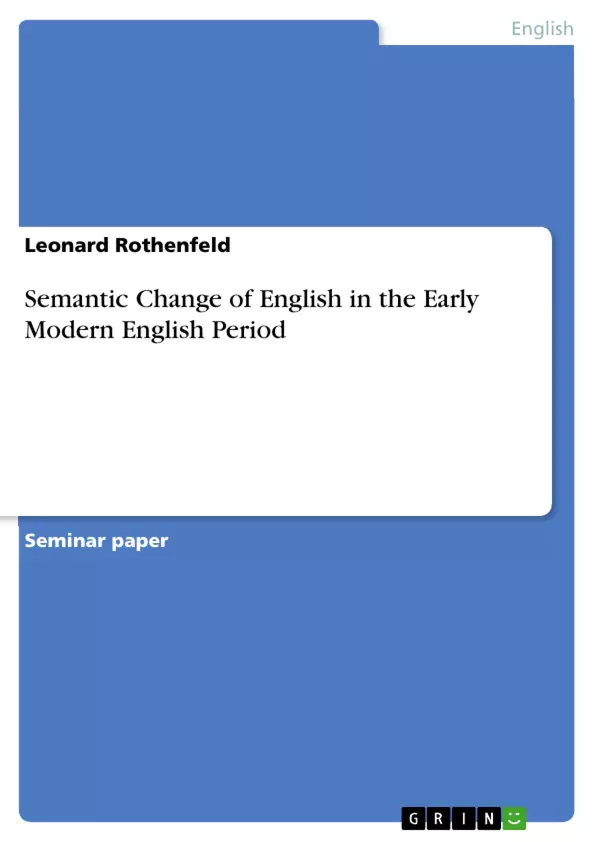This manuscript examines the semantic change in the English language during the Early Modern English (EME) period. It highlights how the meanings of words have changed over time and what social, historical, and psychological factors influenced these changes. The focus is on the various types of semantic change, such as narrowing, broadening, amelioration, and pejoration of meaning. Additionally, the role of Latin during the EME period, as well as the standardization of the English language and the Great Vowel Shift, are discussed. In the final part of the manuscript, a detailed analysis of Sir Thomas Malory's *Le Morte d’Arthur* is conducted to illustrate specific examples of semantic changes through literary texts.
Inhaltsverzeichnis (Table of Contents)
- I. INTRODUCTION
- II. SEMANTIC CHANGE
- a. Types of semantic change
- b. Reasons for semantic change
- i. Social factors
- ii. Historical factors
- iii. Psychological factors
- c. Connection to Jobst Trier's word field theory
- III. EARLY MODERN ENGLISH
- a. Time frame
- b. Characteristics
- c. The role of Latin
- IV. SEMANTIC CHANGE ANALYSIS OF THOMAS MALORY'S LE MORTE D'ARTHUR
- V. CONCLUSION
- VI. REFERENCES
Zielsetzung und Themenschwerpunkte (Objectives and Key Themes)
This paper provides a linguistic analysis of semantic change in the Early Modern English period. The research question explores the nature of semantic change and how words evolved during this time. The paper investigates this through an examination of semantic change types, contributing factors (social, historical, and psychological), and a connection to Jobst Trier's word field theory. It further analyzes semantic shifts in Thomas Malory's Le Morte d'Arthur using corpora and dictionaries.
- Types and classifications of semantic change
- Factors influencing semantic change in Early Modern English
- The role of social and technological advancements in semantic drift
- Analysis of semantic change in a specific Early Modern English text (Le Morte d'Arthur)
- Application of linguistic theories (e.g., Jobst Trier's word field theory) to semantic change
Zusammenfassung der Kapitel (Chapter Summaries)
I. Introduction: This chapter introduces the concept of semantic change using the example of the word "suffer" and sets the stage for the paper's objectives and methodology. It outlines the structure of the paper.
II. Semantic Change: This chapter delves into the definition and types of semantic change, including widening, narrowing, amelioration, and pejoration. It also explores the reasons behind semantic change, focusing on social, historical, and psychological factors. The connection to Jobst Trier's word field theory is also discussed.
III. Early Modern English: This section provides background information on the Early Modern English period, outlining its timeframe, key characteristics, and the influence of Latin.
IV. Semantic Change Analysis of Thomas Malory's Le Morte d'Arthur: This chapter details the methodology used to analyze semantic change within Malory's work, including the corpora and dictionaries consulted. (Note: The actual analysis of the text is excluded here to avoid spoilers.)
Schlüsselwörter (Keywords)
Semantic change, semantic drift, Early Modern English, language evolution, word field theory, Thomas Malory, Le Morte d'Arthur, corpus linguistics, historical linguistics, social factors, technological influence.
- Citar trabajo
- Leonard Rothenfeld (Autor), 2021, Semantic Change of English in the Early Modern English Period, Múnich, GRIN Verlag, https://www.grin.com/document/1518220



